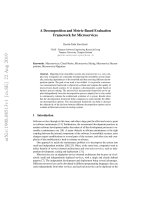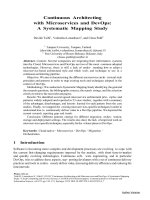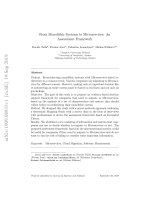IT training thenewstack usecasesforkubernetes khotailieu
Bạn đang xem bản rút gọn của tài liệu. Xem và tải ngay bản đầy đủ của tài liệu tại đây (671.64 KB, 44 trang )
USE CASES
FOR
KUBERNETES
The New Stack:
Use Cases for Kubernetes
Alex Williams, Founder & Editor-in-Chief
Benjamin Ball, Technical Editor & Producer
Gabriel Hoang Dinh, Creative Director
Lawrence Hecht, Data Research Director
Contributors:
Judy Williams, Copy Editor
Norris Deajon, Audio Engineer
TABLE OF CONTENTS
USE CASES FOR KUBERNETES
Overview of the Kubernetes Platform ...................................................................................... 5
Deployment Targets in the Enterprise ...................................................................................14
Intel: Kubernetes in a Multi-Cloud World ..............................................................................20
Key Deployment Scenarios ......................................................................................................21
What to Know When Using Kubernetes .................................................................................31
KUBERNETES SOLUTIONS DIRECTORY
Commercial Distributions & Other Commercial Support for On-Premises Kube .........36
Container Management, Hosted Solutions and PaaS ........................................................37
Tools to Deploy and Monitor Kubernetes Clusters .............................................................39
Integrations .................................................................................................................................41
Disclosures...................................................................................................................................42
USE CASES FOR KUBERNETES
3
SPONSOR
We are grateful for the support of Intel.
USE CASES FOR KUBERNETES
4
ABOUT THE AUTHOR
Janakiram MSV is the Principal Analyst at Janakiram &
Associates and an adjunct faculty member at the
International Institute of Information Technology. He is also
Alcatel-Lucent.
USE CASES FOR KUBERNETES
5
OVERVIEW OF THE
KUBERNETES PLATFORM
by JANAKIRAM MSV
K
ubernetes is a container management platform designed to run
enterprise-class, cloud-enabled and web-scalable IT workloads.
It is built upon the foundation laid by Google based on 15 years
ebook is to highlight how Kubernetes is being deployed by early adopters.
It touches upon the usage patterns and key deployment scenarios of
customers using Kubernetes in production. We’ll also take a look at
companies, such as Huawei, IBM, Intel and Red Hat, working to push
Kubernetes forward.
The Rise of Container Orchestration
The concept of containers has existed for over a decade. Mainstream Unixbased operating systems (OS), such as Solaris, FreeBSD and Linux, had
containers by making them manageable and accessible to both the
development and IT operations teams. Docker has demonstrated that
USE CASES FOR KUBERNETES
5
OVERVIEW OF THE KUBERNETES PLATFORM
Developers and IT operations are turning to containers for packaging code
and dependencies written in a variety of languages. Containers are also
playing a crucial role in DevOps processes. They have become an integral
part of build automation and continuous integration and continuous
deployment (CI/CD) pipelines.
The interest in containers led to the formation of the Open Container
Initiative
formats. The industry is also witnessing various implementations of
containers, such as LXD by Canonical, rkt by CoreOS, Windows Containers
CRI-O — being reviewed through the Kubernetes Incubator,
and vSphere Integrated Containers by VMware.
While core implementations center around the life cycle of individual
containers, production applications typically deal with workloads that
FIG 1: High-level architecture of a container orchestration engine.
Container Orchestration Engine
Cluster 3
Cluster n
Application
Application
Application
Cluster 1
Cluster 2
Application
Application
Application
Cluster Manager / Orchestration Engine
VM
VM
VM
VM
VM
VM
VM
Physical Infrastructure
USE CASES FOR KUBERNETES
Source: Janakiram MSV
6
OVERVIEW OF THE KUBERNETES PLATFORM
architecture dealing with multiple hosts and containers running in
production environments demands a new set of management tools.
Some of the popular solutions include Docker Datacenter, Kubernetes,
and Mesosphere DC/OS.
packaging, deployment, isolation, service discovery, scaling and rolling
upgrades. Most mainstream PaaS solutions have embraced containers,
and there are new PaaS implementations that are built on top of container
orchestration and management platforms. Customers have the choice of
either deploying core container orchestration tools that are more aligned
developers.
The key takeaway is that container orchestration has impacted every
will play a crucial role in driving the adoption of containers in both
enterprises and emerging startups.
Kubernetes Architecture
Like most distributed computing platforms, a Kubernetes cluster consists
of at least one master and multiple compute nodes. The master is
responsible for exposing the application program interface (API),
scheduling the deployments and managing the overall cluster.
Each node runs a container runtime, such as Docker or rkt, along with an
agent that communicates with the master. The node also runs additional
components for logging, monitoring, service discovery and optional
add-ons. Nodes are the workhorses of a Kubernetes cluster. They expose
USE CASES FOR KUBERNETES
7
Kubernetes Architecture
OVERVIEW OF THE KUBERNETES PLATFORM
Image Registry
UI
Node 1
User
Interface
Node 2
API
Kubernetes
Master
Node 3
CLI
Command
Line
Interface
Node n
Source: Janakiram MSV
FIG 2: Kubernetes breaks down into multiple architectural components.
compute, networking and storage resources to applications. Nodes can
be virtual machines (VMs) in a cloud or bare metal servers in a datacenter.
A pod is a collection of one or more containers. The pod serves as
Kubernetes’ core unit of management. Pods act as the logical boundary
for containers sharing the same context and resources. The grouping
processes together. At runtime, pods can be scaled by creating replica
sets, which ensure that the deployment always runs the desired number
of pods.
Replica sets deliver the required scale and availability by maintaining a
exposed to the internal or external consumers via services. Services
USE CASES FOR KUBERNETES
8
Kubernetes Master
OVERVIEW OF THE KUBERNETES PLATFORM
Im
Kubernetes Master
UI
User
nterface
API Server
Scheduler
Controller
API
CLI
etcd
ommand
Line
nterface
Source: Janakiram MSV
FIG 3: The master is responsible for exposing the API, scheduling the deployments
and managing the overall cluster.
criterion. Pods are associated to services through key-value pairs called
labels and selectors. Any new pod with labels that match the selector will
automatically be discovered by the service.
node. The node pulls the images from the container image registry and
coordinates with the local container runtime to launch the container.
etcd is an open source, distributed key-value database from CoreOS,
which acts as the single source of truth (SSOT) for all components of the
Kubernetes cluster. The master queries etcd to retrieve various
USE CASES FOR KUBERNETES
9
Kubernetes Node
OVERVIEW OF THE KUBERNETES PLATFORM
Image Registry
Node 1, 2, 3, n
Optional Add-ons: DNS, UI, etc.
Pod
Kubernetes
Master
Pod
Pod
Pod
Pod
Pod
Pod
Pod
Pod
Pod
Pod
Pod
Supervisord
Docker
kubelet
kube-proxy
Fluentd
Source: Janakiram MSV
FIG 4: Nodes expose compute, networking and storage resources to applications.
parameters of the state of the nodes, pods and containers. This
architecture of Kubernetes makes it modular and scalable by creating an
abstraction between the applications and the underlying infrastructure.
Key Design Principles
Kubernetes is designed on the principles of scalability, availability, security
distributing the workload across available resources. This section will
highlight some of the key attributes of Kubernetes.
Workload Scalability
Applications deployed in Kubernetes are packaged as microservices.
These microservices are composed of multiple containers grouped as
pods. Each container is designed to perform only one task. Pods can be
USE CASES FOR KUBERNETES
10
OVERVIEW OF THE KUBERNETES PLATFORM
composed of stateless containers or stateful containers. Stateless pods
can easily be scaled on-demand or through dynamic auto-scaling.
scales the number of pods in a replication controller based on CPU
auto-scale rules and thresholds.
Hosted Kubernetes running on Google Cloud also supports cluster autoscaling. When pods are scaled across all available nodes, Kubernetes
coordinates with the underlying infrastructure to add additional nodes to
the cluster.
An application that is architected on microservices, packaged as
containers and deployed as pods can take advantage of the extreme
scaling capabilities of Kubernetes. Though this is mostly applicable to
stateless pods, Kubernetes is adding support for persistent workloads,
such as NoSQL databases and relational database management systems
(RDBMS), through pet sets; this will enable scaling stateless applications
such as Cassandra clusters and MongoDB replica sets. This capability will
bring elastic, stateless web tiers and persistent, stateful databases
together to run on the same infrastructure.
High Availability
Contemporary workloads demand availability at both the infrastructure
and application levels. In clusters at scale, everything is prone to failure,
which makes high availability for production workloads strictly necessary.
application availability, Kubernetes is designed to tackle the availability of
both infrastructure and applications.
On the application front, Kubernetes ensures high availability by means of
replica sets, replication controllers and pet sets. Operators can declare
USE CASES FOR KUBERNETES
11
OVERVIEW OF THE KUBERNETES PLATFORM
the minimum number of pods that need to run at any given point of time.
If a container or pod crashes due to an error, the declarative policy can
For infrastructure availability, Kubernetes has support for a wide range of
NFS) and GlusterFS, block storage devices such as
Elastic Block Store (EBS) and Google Compute Engine persistent disk, and
Flocker. Adding a reliable,
available storage layer to Kubernetes ensures high availability of stateful
workloads.
Each component of a Kubernetes cluster — etcd, API server, nodes – can
balancers and health checks to ensure availability.
Security
are secured through transport layer security (TLS), which ensures the user
is authenticated using the most secure mechanism available. Kubernetes
clusters have two categories of users — service accounts managed
directly by Kubernetes, and normal users assumed to be managed by an
independent service. Service accounts managed by the Kubernetes API
are created automatically by the API server. Every operation that manages
a process running within the cluster must be initiated by an authenticated
user; this mechanism ensures the security of the cluster.
Applications deployed within a Kubernetes cluster can leverage the
concept of secrets to securely access data. A secret is a Kubernetes object
that contains a small amount of sensitive data, such as a password, token
or key, which reduces the risk of accidental exposure of data. Usernames
USE CASES FOR KUBERNETES
12
OVERVIEW OF THE KUBERNETES PLATFORM
and passwords are encoded in base64 before storing them within a
Kubernetes cluster. Pods can access the secret at runtime through the
mounted volumes or environment variables. The caveat is that the secret
is available to all the users of the same cluster namespace.
applied to the deployment. A network policy in Kubernetes is a
each other and with other network endpoints. This is useful to obscure
pods in a multi-tier deployment that shouldn’t be exposed to other
applications.
Portability
operating systems, container runtimes, processor architectures, cloud
platforms and PaaS.
distributions, including CentOS, CoreOS, Debian, Fedora, Red Hat Linux
and Ubuntu. It can be deployed to run on local development machines;
environments based on KVM, vSphere and libvirt; and bare metal. Users
can launch containers that run on Docker or rkt runtimes, and new
container runtimes can be accommodated in the future.
Through federation, it’s also possible to mix and match clusters running
across multiple cloud providers and on-premises. This brings the hybrid
move workloads from one deployment target to the other. We will discuss
the hybrid architecture in the next section.
USE CASES FOR KUBERNETES
13
DEPLOYMENT TARGETS
IN THE ENTERPRISE
by JANAKIRAM MSV
K
are using, it’s important to identify the implementations that they
are most likely to adopt. There are several deployment models for running
production workloads that vendors have already targeted with a suite of
products and services. This section highlights these models, including:
• Managed Kubernetes and Containers as a Service.
• Public Cloud and Infrastructure as a Service.
• On-premises and data centers.
• Hybrid deployments.
Managed Kubernetes and Containers as a
Service
A managed Kubernetes cluster is hosted, maintained and managed by a
commercial vendor. Based on PaaS concepts, this delivery model is called
USE CASES FOR KUBERNETES
14
Containers as a Service Architecture
DEPLOYMENT TARGETS IN THE ENTERPRISE
Application Services
Cluster Manager
Container Registry
Log Management
Controller
Scheduler
Health &
Monitoring
Service
Discovery
Core Container Services
Compute
Storage
Networking
Physical Infrastructure
Source: Janakiram MSV
FIG 1: The components that make up the architecture of a CaaS solution.
driven high availability and scalability of infrastructure. CaaS goes beyond
exposing the basic cluster to users. Google Container Engine (GKE),
,
and Rackspace
Carina
with other essential services such as image registry, L4 and L7 load
balancers, persistent block storage, health monitoring, managed
databases, integrated logging and monitoring, auto scaling of pods and
nodes, and support for end-to-end application lifecycle management.
cloud. Many customers get started with Kubernetes through Google
Google, GKE delivers automated container management and integration
USE CASES FOR KUBERNETES
15
DEPLOYMENT TARGETS IN THE ENTERPRISE
Container Management Solutions
Cloud Container Engine (Huawei) A scalable, high-performance container service based on Kubernetes.
CloudStack Container Service (ShapeBlue) A Container as a Service solution that combines the power of Apache
CloudStack and Kubernetes. It uses Kubernetes to provide the underlying platform for automating deployment, scaling and
operation of application containers across clusters of hosts in the service provider environment.
Google Container Engine (Google) Google Container Engine is a cluster management and orchestration system that lets
users run containers on the Google Cloud Platform.
Kubernetes as a Service on Photon Platform (VMware) Photon is an open source platform that runs on top of
VMware’s NSX, ESXi and Virtual SAN. The Kubernetes as a Service feature will be available at the end of 2016.
with other Google Cloud services such as logging, monitoring, container
registry, persistent disks, load balancing and VPN.
GKE only exposes the nodes of the Kubernetes cluster to customers, while
managing the master and etcd database itself. This allows users to focus
on the applications and avoid the burden of infrastructure maintenance.
With GKE, scaling out a cluster by adding new nodes can be done within
minutes. GKE can also upgrade the cluster to the latest version of
Kubernetes, ensuring that the infrastructure is up-to-date. Customers can
point tools such as kubectl to an existing GKE cluster to manage
application deployments.
AppsCode, KCluster and
StackPointCloud. AppsCode delivers complete application lifecycle
management of Kubernetes applications, while providing the choice of
running the cluster on AWS or Google Cloud. KCluster is one of the
emerging players in the hosted Kubernetes space. It runs on AWS, with
other cloud platform support planned for the future. StackPointCloud
focuses on rapid provisioning of clusters on AWS, Packet, DigitalOcean,
Tectonic, Prometheus, Deis, fabric8 and Sysdig.
USE CASES FOR KUBERNETES
16
DEPLOYMENT TARGETS IN THE ENTERPRISE
Hosted Kubernetes and PaaS Solutions
AppsCode (AppsCode) Integrated platform for collaborative coding, testing and deploying of containerized apps. Support
is provided for deploying containers to AWS and Google Cloud Platform.
(Engine Yard)
cluster.
Eldarion Cloud (Eldarion) DevOps services and development consulting, packaged with a PaaS powered by Kubernetes,
CoreOS and Docker. It includes Kel, a layer of open source tools and components for managing web application deployment
and hosting.
Giant Swarm (Giant Swarm) A hosted container solution to build, deploy and manage containerized services with
Hasura Platform (34 Cross Systems) A platform for creating and deploying microservices. This emerging company's
infrastructure is built using Docker and Kubernetes.
Hypernetes (HyperHQ) A multi-tenant Kubernetes distribution. It combines the orchestration power of Kubernetes and
the runtime isolation of Hyper to build a secure multi-tenant CaaS platform.
KCluster (KCluster) A hosted Kubernetes service that assists with automatic deployment of highly available and scalable
production-ready Kubernetes clusters. It also hosts the Kubernetes master components.
OpenShift Container Platform (Red Hat) A container application platform that can span across multiple infrastructure
footprints. It is built using Docker and Kubernetes technology.
OpenShift Online (Red Hat) Red Hat’s hosted version of OpenShift, a container application platform that can span across
multiple infrastructure footprints. It is built using Docker and Kubernetes technology.
Platform9 Managed Kubernetes for Docker (Platform9)
utilize Platform9’s single pane of glass, allowing users to orchestrate and manage containers alongside virtual machines. In
other words, you can orchestrate VMs using OpenStack and/or Kubernetes.
StackPointCloud (StackPointCloud) Allows users to easily create, scale and manage Kubernetes clusters of any size with
the cloud provider of their choice. Its goal is to be a universal control plane for Kubernetes clouds.
Public Cloud and Infrastructure as a
Service
Apart from signing up for a managed Kubernetes CaaS running in the
and integrate it with the native features of Infrastructure as a Service
(IaaS).
USE CASES FOR KUBERNETES
17
DEPLOYMENT TARGETS IN THE ENTERPRISE
CoreOS is one of the most preferred operating systems used to run
Kubernetes in the public cloud. The company has comprehensive
documentation and step-by-step guides for deploying Kubernetes in a
variety of environments.
With each release, Kubernetes is becoming easier to install. In version 1.4,
a new tool called kubeadm attempts to simplify the installation on
machines running CentOS and Ubuntu. Customers can get a fully
functional cluster running in just four steps.
On-Premises and Data Centers
or bare metal servers to deliver better performance. When deploying
requirements for image registry, image scanning, monitoring and logging
components.
and enterprise PaaS based on Kubernetes. Tectonic from CoreOS and the
Canonical Distribution of Kubernetes are examples of commercial
Red Hat
and Apprenda are application platforms built on top of
Kubernetes. They provide end-to-end application lifecycle management
capabilities for cloud-native applications.
Hybrid Deployments
Kubernetes deployment that spans the on-premises datacenter and
USE CASES FOR KUBERNETES
18
DEPLOYMENT TARGETS IN THE ENTERPRISE
public cloud. It leverages the virtual networking layer provided by the
cloud vendor and the concept of federated clusters in Kubernetes.
Kubernetes cluster federation can integrate clusters running across
cloud platforms. Federation creates a mechanism for multi-cluster
geographical replication, which keeps the most critical services running
even in the face of regional connectivity or data center failures.
The hybrid architecture, based on federated clusters, enables
moving the internet-facing, elastic workloads to the public cloud. With
across multiple deployment targets, and save on operating costs by
regions.
USE CASES FOR KUBERNETES
19
KUBERNETES IN A
MULTI-CLOUD WORLD
In a discussion with Jonathan Donaldson of Intel,
we talk about Intel’s motivations for taking an
active and invested role in the Kubernetes
ecosystem. Kubernetes’ capabilities as a platform
for automating deployments and orchestrating applications is a
game-changer for both multi-cloud service providers and
customers. Kubernetes is also able to combine with solutions such
as OpenStack to address the need for health monitoring, making
services highly available, and scaling services as needed. This kind
maintaining infrastructure. Overall, Intel sees Kubernetes as a way
it a technology worth investing in and encouraging further
adoption by end users. Listen on SoundCloud
Jonathan Donaldson is the vice president of the Data Center Group
carrying out Intel’s strategy for private, hybrid and public cloud automation.
Donaldson previously worked at companies such as VCE, EMC, NetApp and
Cisco, holding various leadership and technical roles that encompassed
marketing and emerging technologies.
USE CASES FOR KUBERNETES
20
KEY DEPLOYMENT
SCENARIOS
by JANAKIRAM MSV
ubernetes is deployed in production environments as a
container orchestration engine, PaaS, and as core infrastructure
for managing cloud-native applications. These use cases are
not mutually exclusive. It is possible for DevOps to delegate complete
application lifecycle management (ALM) to a PaaS layer based on
Kubernetes. They may also use a standalone Kubernetes deployment
to manage applications deployed using the existing CI/CD toolchain.
Customers building greenfield applications can leverage Kubernetes
for managing the new breed of microservices-based cloud-native
applications through advanced scenarios such as rolling upgrades
and canary deployments.
K
This section looks to capture the top customer use cases involving
Kubernetes. Before highlighting the key deployment scenarios of
Kubernetes, let’s take a closer look at the essential components of an
enterprise container management platform.
USE CASES FOR KUBERNETES
21
Container Management Platform
KEY DEPLOYMENT SCENARIOS
DevOps Toolchain:
Container Runtime
Container Runtime
Container Runtime
Host OS
Host OS
Host OS
Monitoring / Logging
Secure Image Registry
Container Orchestration
Physical Infrastructure
Source: Janakiram MSV
FIG 1: A closer look at the essential components of an enterprise container
management platform.
The Building Blocks of an Enterprise
Container Management Platform
the container management platform. This model of platform is becoming
increasingly prevalent, and is critical for deploying and managing
containers in production.
Operating System
Containers reduce the dependency of applications on the underlying
operating system. Lightweight operating systems, like CoreOS and Red
Hat Atomic Host
reduced footprint results in lower management costs of infrastructure.
USE CASES FOR KUBERNETES
22
KEY DEPLOYMENT SCENARIOS
Container Engine
Container engines manage the life cycle of each container running on a
engine to schedule containers across the nodes of a cluster. Docker and
rkt are two examples of container engines.
Image Registry
The image registry acts as the central repository for container images. It
provides secure access to images that are used by the orchestration
engine at runtime. Docker Trusted Registry, CoreOS Quay Enterprise and
JFrog Artifactory are some of the available choices.
Image Security
applications, they need to be scanned for vulnerabilities and potential
threats. CoreOS Clair, Twistlock, and OpenSCAP can be used for scanning
images.
Container Orchestration
It provides distributed cluster management and container scheduling
services. Kubernetes, Docker native orchestration and DC/OS deliver
container orchestration and management.
Distributed Storage
Containers demand a new breed of distributed storage to manage stateful
workloads. Products such as ClusterHQ, Portworx, Joyent Manta and
Diamanti
Monitoring
Production workloads need constant visibility into the status and health
of applications. The monitoring solution needs to span infrastructures and
USE CASES FOR KUBERNETES
23
KEY DEPLOYMENT SCENARIOS
the containers deployed in it. Datadog, Sysdig and Prometheus are
examples of container monitoring services.
Logging
reliability of containers and their hosts. As with any production workload,
logging is a critical component. Splunk, Loggly and Logentries provide
logging services for containers.
Source Control Management
Though source code management (SCM) is typically used for maintaining
revisions of source code, it also plays an important role in versioning
Kubernetes object declarations. Existing SCM solutions, such as GitHub,
Bitbucket and GitLab, are used for managing both code and artifacts.
Build Automation
tools, such as Shippable, or existing tools, like Jenkins, can be extended
for automating deployments.
Chef, Puppet, Ansible and
SaltStack
applications.
USE CASES FOR KUBERNETES
24









